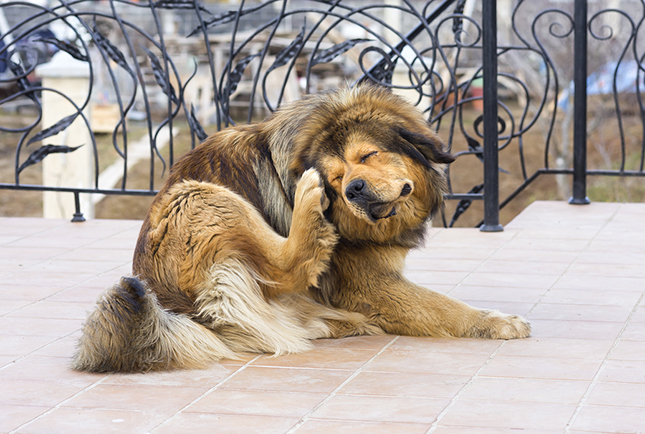Prevention of Fleas is Important Year-Round

One of the worst things about this time of year is the increase of fleas on pets, outside, and, possibly, in homes. Flea prevention is crucial since adult fleas cause the most problems for pets. In order to become adult fleas, the blood-sucking creatures need warm weather, between 70 and 80 degrees Fahrenheit, and about 70 to 80 percent humidity, said Dr. Alison Diesel, lecturer in dermatology at Texas A&M University College of Veterinary Medicine & Biomedical Sciences (CVM).
“Those ideal conditions are exactly what we are experiencing during this time of the year, which is why we generally see more fleas coming out in the spring,” Diesel said.
She added that fleas can be present year-round in Texas because there is not usually a “true winter.”
Fleas can cause various problems for pets. Some animals, for example, are allergic to an allergen in the flea saliva causing the animal to have an allergic reaction. This causes the animal to scratch, which could lead to a secondary bacterial skin infection. If there is a large flea problem, anemia could be a potential problem, especially among small animals that do not have large amounts of blood. Fleas can also carry diseases such as tapeworms or Bartonella, and infect both pets and humans.
Amanda Friedeck, a veterinary technician at the CVM, said there is no way to completely prevent fleas, but a key factor to controlling fleas is breaking the life cycle.
“The best way to control fleas is to break the cycle. More fleas lay more eggs. … The best treatment either kills the adults or kills one of the juvenile stages,” Friedeck said.
Diesel said the flea life cycle has four phases: the adult fleas lay eggs, the eggs hatch into larvae, the larvae turns into pupae, which, eventually, turn into adults.
“Ideally, targeting several phases of the flea lifecycle is best, particularly when dealing with an infestation. The easiest stage to target is the adult flea since these lives on the pet. The other stages (eggs, larvae, pupae) are present in the environment,” Diesel said.
Both Diesel and Friedeck said the best way to determine treatment of an animal’s flea problem is to take them to a veterinarian to discuss the best options and medications.
“Your pet’s veterinarian can help recommend the most appropriate product to help prevent fleas based on other factors (e.g. other skin conditions, food allergies, etc.) as well as discuss the appropriate way to administer the product (e.g. orally or topically),” Diesel said.
Diesel suggested using a flea prevention that lasts the entire month and is still effective if the pet gets wet.
“Using flea prevention every 30 days, or more frequently in some situations, can provide the best protection from fleas biting your pet, can kill adult fleas rapidly, and can prevent a flea infestation from being established in your pet’s environment,” Diesel said
Diesel and Friedeck agreed that it is important to minimize an animal’s exposure to fleas by avoiding infested areas and pets coming in contact with animals that have fleas such as wild animals.
“There are some things which can be done to minimize exposure to fleas: avoid known infested areas, do not allow your pet to come into contact with wild animals or burrows, and protect areas of the house where wild animals may enter to minimize wild animals from establishing residency in the first place,” Diesel said.
If fleas become a problem inside the house, Diesel and Friedeck suggested vacuuming once a week.
“Vacuuming is a very good way to rid of fleas in the house, but the bag must be thrown away and removed from the house,” Friedeck said.
She added that if there is a large flea presence, there are in-house treatments and exterminators.
“There are some in-house treatments and bombs, but they should only be used in heavily burdened environments,” Friedeck said.
Diesel suggested focusing on places where the pets spends most of their time inside the house when bombing because that will contain the most concentrated area of fleas.
“Don’t forget under beds and furniture, behind curtains, and along hallways connecting rooms when treating the house for fleas. Again, it may be best to contact a professional exterminator when there is a large flea burden present,” she said.
In addition to treating animals and inside of homes, it may be necessary to treat the outside environment. This can be done by spraying areas of the yard that are high in flea population.
“This includes shaded areas, under trees and bushes, in dog houses, under porches and decks. As with indoor control, when the burden is high, a professional exterminator may be the most help,” Diesel said.
Diesel said the best strategy against fleas is to practice year-round prevention by treating all pets with flea medicine as well as treating inside and outside the home if an infestation is suspected.
“It is much easier to prevent fleas than to treat fleas,” she said.
Pet Talk is a service of the College of Veterinary Medicine & Biomedical Sciences, Texas A&M University. Stories can be viewed on the Web at /pet-talk. Suggestions for future topics may be directed to cvmtoday@cvm.tamu.edu.


